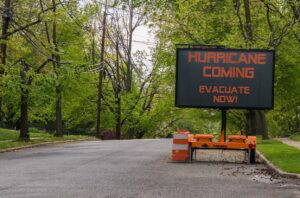Portable generators are typically used after natural disasters, such as hurricanes or massive snowstorms. Unfortunately, when disaster strikes, people tend to panic, and safety isn’t always top of mind. That’s why it’s important to learn generator safety precautions before you need to use one.
With cold temperatures already here and winter on the horizon, we reached out to Brett Brenner, president of the Electrical Safety Foundation International. Brett shared with us generator safety tips to help keep you safe after disaster strikes.
The biggest generator danger
“The thing that we see all the time with disasters and portable generators is – people just forget that there’s deadly carbon monoxide that can kill you,” says Brett.
Homeowners make the terrible mistake of placing the generator too close to the house or garage. This can lead to carbon monoxide (CO) buildup in the home from exhaust fumes.
“Let’s say you put a generator 10 feet away from your house,” says Brett, “but somebody comes along behind you and opens a window that’s relatively close to that generator and the wind shifts.”
In this scenario, CO can get back into the house, and it’s odorless and tasteless. Unfortunately, you won’t know your home has carbon monoxide in it until it’s too late. That’s why one of the most important generator safety precautions is having working CO detectors in the right areas.

“Carbon monoxide is heavier than air, so it’s typically low,” explains Brett. “As it gets worse and worse, it’ll start to rise, but by the time it gets to the ceiling, especially on a second floor, it would be an issue.”
Improperly installed CO detectors may not be helpful and can lead to dangerous situations.
“You need to make sure that you’re following the detector’s directions to say where it should be put,” says Brett.
Also, as part of your generator safety precautions, test your CO detectors regularly to make sure they’re working. A non-functioning CO detector alerts no one.
General generator safety precautions
“You have to be mentally prepared to take some safety precautions, to make sure you don’t put yourself, your neighbors, first responders, or utility workers in danger,” says Brett.
Before you start your generator, take the necessary precautions, including:
- Understanding that generators are not “plug and play” devices.
- Following the manufacturer’s instructions (do not throw out your manual).
- Having a qualified electrician install a transfer switch (if needed).
- Using a transfer switch correctly and GFCI protection.
- Making sure your generator is properly grounded. (All generators need to be grounded.)
- Keeping the generator as far away from the home as you can (at least 20 feet).
- Operating generators for temporary emergency use only.
- Plugging your generator into your home the right way to avoid backfeeding the area (which can be deadly).
Can I backfeed my house with a generator?

Yes, but you shouldn’t. Backfeeding occurs when a homeowner hooks up their generator the wrong way (without a transfer switch) and sends electricity into the electrical panel. When this happens, electricity will find the path of least resistance and create problems for utility workers on the power lines.
Warns Brett, “There have been instances where a utility line worker has been killed because somebody didn’t plug their generator correctly, powered half the neighborhood, and nobody knew about it.”
While you should have a transfer switch installed in your home, you should make sure you’re using the voltage recommended by the manufacturer.
“Sometimes people get creative and decide they’re going to try to backfeed their whole house with a generator by using their dryer outlet, which has a 240-volt circuit.”
For the safety of your neighbors and electrical workers, avoid powering appliances and devices that aren’t supposed to be powered by a generator.
Is there one type of generator that’s safer than others?
A professional-installed generator that is mounted correctly and far enough away from the house may be one of the safest options.
“There’s some safeguards built into a permanently-mounted generator,” says Brett. “You’ve got a transfer switch, so it clicks over automatically or you have to do it manually.”
While there isn’t anything inherently unsafe about portable generators, there are more uncertainties that can lead to dangerous situations.
“As long as you’re conscious of the CO side of things and you’re not plugging in things you shouldn’t be, [most generators] are relatively safe,” says Brett. “You just have to be super, super cautious because it is a running engine, and you’ve got to be careful that you’re just not putting others in danger.”
Potential safe alternatives to generators
Before disaster strikes, it’s best to be as prepared as possible. New technologies can help to keep you safe and power up some electronics without the dangers associated with generator use.
“I’m exploring it for our house,” says Brett, “and there’s a lot of great battery options.”
New battery banks can help you charge your cell phone or even a workstation for most of the day. You may not be able to run a refrigerator off these devices (right now).
“We have moved out from Washington DC to the Midwest, and sump pumps are obviously a big thing here,” said Brett. “So I was looking for a backup power source just in case.”
At a recent conference, Brett discovered new applications that can help power your household necessities during a power outage.
“For the things that you really, really need, you might be okay with some of the battery options that are coming into the market now.”
Expert tips at your fingertips
Homeownership can be hard, but it doesn’t have to be. The vipHome.app can help. In less than four minutes, enjoy a new way to manage your home. Simply download the app, register your home, and enjoy a simplified homeownership experience.
Download the app today!








